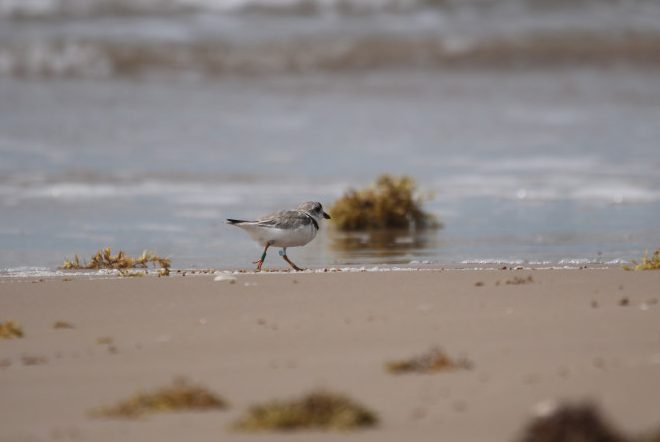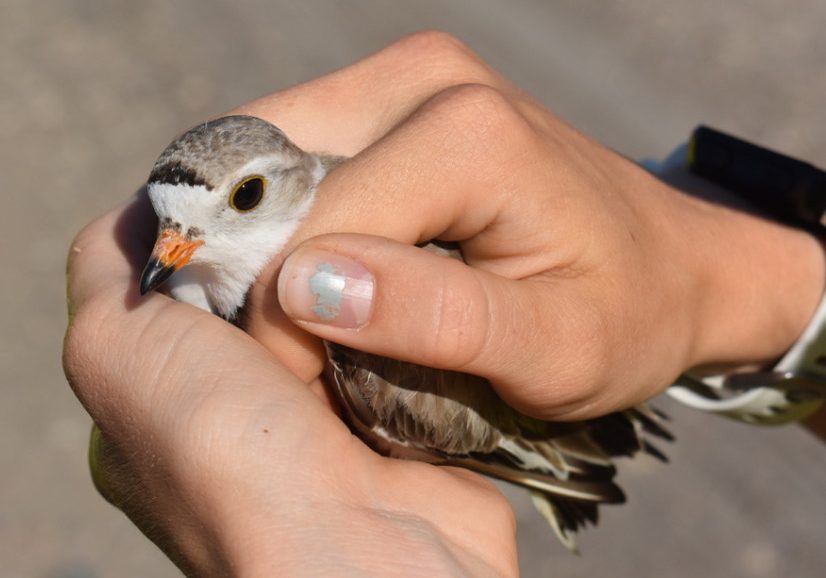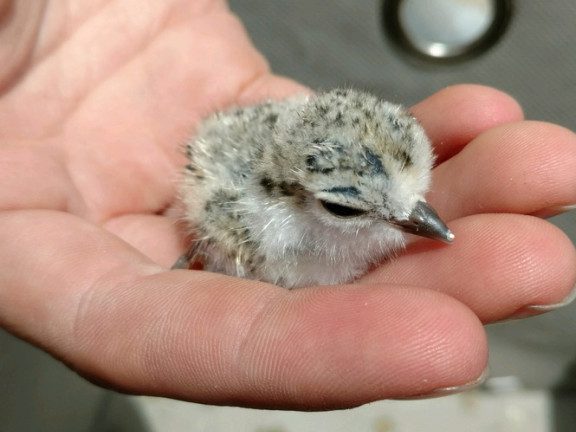
By Elsa Forsberg
I zoom in again on my computer screen, just to make sure the image is of a small shorebird called a piping plover. Two plastic bands decorate the bird’s legs like bracelets, one gray and one blue. The combination of different colored bands serves as a coded name tag waiting to be deciphered. Squinting at the blue band, I read the white engraved text.
56A.
I sit back and gape at my computer screen. I know that bird. I held that bird in my left hand when I placed those bands on his legs. Now he’s 1,500 miles away.
The last time I saw 56A was at a sand and gravel mine near Louisville, Nebraska. There, I watched him successfully hatch a nest of four chicks. That was in June. By July 27, plover 56A made a successful migration all the way to Quintana Roo, Mexico, where he happened to be spotted by another biologist. That’s a pretty incredible journey for a bird that weighs only 50 grams. He’ll do it again in a matter of months, making the return trip for the nesting season in the summer, when I hope to set eyes on him again and know that he’s still alive.
As I record the sighting into a database, I wonder about 56A’s future. Will he return to nest in the same place next summer? Will his chicks survive? What will be the next chapter of his story?
Banding Plovers
Piping plovers (Charadrius melodus) are listed as threatened on the federal and Nebraska state endangered species lists, and they live extraordinary lives. In the summer, piping plovers breed in a handful of regions across North America, including Nebraska. The basics for a piping plover nest are sand and water. Historically, that meant river sandbars. However, piping plovers have also found places to nest off the river: sand and gravel mines. As a by-product of the aggregate mining process, the mines incidentally provide flat expanses of sand surrounded by a small lake. With sand and water, the piping plovers find a spot to lay their nest and forage for invertebrates at the water’s edge. Some mines become lakeshore housing developments, which continue to host nesting piping plovers.

Amidst all the mining machinery and residential activity, the plovers hatch and raise chicks that will hopefully boost the declining population. The Tern and Plover Conservation Partnership exists to help, facilitating cooperation between the sand and gravel companies, developers, homeowners and researchers at the University of Nebraska-Lincoln, the Nebraska Game and Parks Commission and the U.S. Fish and Wildlife Service. As a graduate student at UNL, I work with the Partnership to protect and monitor piping plovers, their nests and chicks during the summer until they migrate south.
By using leg bands, researchers keep track of plovers like 56A. With only one year of records for 56A, we don’t know much about his life yet, but we do know more about many others. Most plovers from Nebraska spend the winter on beaches in the Gulf of Mexico and on the Atlantic Coast. If someone spots one of our piping plovers, the leg bands tell us which bird it is. In the summers, I record which birds return, some of them raising their fourth or fifth brood of chicks in so many years. Each time someone sees a bird, we add another line to its story.
Most of these stories are archived in a database and compiled in TPCP’s annual reports at ternandplover.unl.edu. Over the years, with more than 800 birds banded, we have compiled a lot of data. But it isn’t just data that can be summarized in a table. They are the life stories of piping plovers like 56A, who nest and raise chicks in unlikely places and migrate more than a thousand miles to do it all over again.
Piping Plover No. 89
Consider piping plover 89. Our first record of 89 comes from 2010, when he raised a nest at a lakeshore housing development near Schuyler. The neighborhood was pretty quiet plover-wise that year, with 89’s nest the sole plover residence amid the houses being built on the sand next door.
In the second week of May, 89 and his mate chose a spot farthest from the home construction, dug a shallow depression into the sand and settled in. For four weeks, the pair took turns incubating four eggs and caring for their nest. During that time, the Partnership discovered them and placed a protective predator exclosure and informative signage around the nesting area. They also put colorful bands on 89’s legs: metal, yellow and gray on the left leg with light blue, green and green on the right.
On a Monday in mid-June, the eggs hatched. Eighty-nine worked together with his mate to teach the chicks how to find insects in the sand and how to hide from predators in the small shadows under cottonwood seedlings. When the chicks were six days old, researchers weighed them — each about 7.2 grams — and gave them leg bands of their own. Marking chicks allows us to track the impact of plovers through generations.

We don’t know much about 89’s life in 2011 nor 2012. Our records pick back up in 2013, when the Partnership team found him on a Platte River sandbar near Ashland. While the researchers didn’t identify 89 with a nest that summer, they observed him on the same sandbar three more times between June and July. The sandbar is about 45 miles, as the plover flies, from 89’s prior summer spot in Schuyler, and likely quite a different environment than the lakeshore housing development. Instead of home construction and human neighbors, 89 spent the summer of 2013 next to rushing river waters.
By 2014, plover 89 was back on the nest. This time, he made his summer home at a third kind of habitat: a sand and gravel mine. We don’t know what happened with 89’s nest that year. By June 17, the nest disappeared a week before its expected hatch date. Eighty-nine was still around by June 23, but no chicks were seen.
So far in his life, 89 has spent time in several nesting habitat types: first a lakeshore housing development, then a river sandbar, then a sand and gravel mine. The Partnership identifies one other type of off-river nesting habitat: transition sites, a stage during which an old sand gravel mine becomes a lakeshore housing development. Eighty-nine spent the summers of 2015 and 2016 at a transition site near Ashland. As far as we know, he did not nest during those two years.
But, one day in May 2017, the team spotted a plover at this same transition site. Looking closer, the color band combination read: light blue flag on the upper left leg, yellow over gray on the lower left, metal band on the upper right, green over green on the lower right. The researchers continued to watch and observed the plover settle into a specific spot in the sand. That’s when they knew: After two years, 89 was back on the nest. This time, 89 paired with an unbanded plover, and together, they incubated 4 eggs. Interestingly, something happened with one of the eggs in the second week, and the pair decided to remove it and continue incubating the remaining three eggs.
On June 9, the researchers returned to find 89’s nest empty. Eighty-nine and his mate were nearby protecting three chicks. The nest hatched! All three chicks were banded and named 738, 739 and 740. Eighty-nine and his partner took care of their young for several weeks, and all three chicks survived to fledge, earning their flight feathers for their first migration.
Eighty-nine has not been seen in Nebraska since 2017. However, we know that he is alive. While we aren’t sure where 89 spends the summer months, we know where he spends his winters. His first winter sighting was in 2018, when a researcher spotted him on the Matagorda Peninsula on the Gulf Coast of Texas. There, 89 spends much of his time foraging for marine worms and insects in the wet tidal sand without much disturbance from people. He returned in 2019, 2020 and 2021, where he was observed by the same researcher each time.
In 2022, we received a report that 89 was back on the Texas coast, having made the migration again. The researcher who observed 89 attached a photo to the email. I opened the image to find a plover and carefully matched the colored bands on its legs.
The incredibleness of 89’s life hit me when I saw that photo. Since he was banded as an adult in 2010, that meant 89 was at least 13 years old in 2022. That’s pretty old for a piping plover, a species with an average lifespan of 5 years. In those 13 years, 89 had three nests at three different nesting site types and raised at least five chicks.
That’s quite a legacy to contribute to the declining population of the threatened species. In seven summers, 89 experienced every nesting habitat that Nebraska had to offer: a river sandbar, a sand and gravel mine, a lakeshore housing development and a transition site. He’s been seen by Partnership staff 18 times, and Texas coast researchers have seen him 11 times.
Wherever 89 is resting his wings now, it isn’t the end of the story.
If you spot a banded piping plover (or any other bird), you can help researchers by reporting the sighting to the USGS Bird Banding Laboratory at pwrc.usgs.gov/BBL/bblretrv/.
